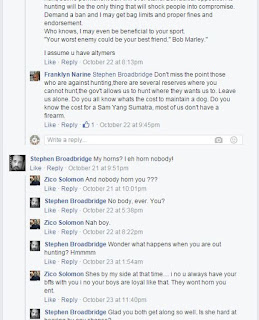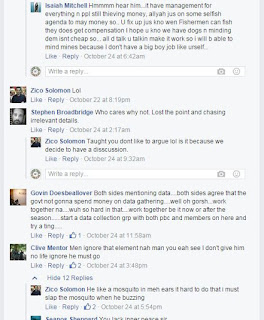Picture taken from Saturday Express online article.
THERE is growing outrage over the number of wildlife being slaughtered since the re-opening of the hunting season, with the latest kill being a protected river otter.
Photographs of the bloody animal sprawled on a pavement in San Fernando have angered founder of the El Socorro Centre for Wildlife Conservation Ricardo Meade.
The otter was being sold by a hunter.
Meade said the creature is very rare to find.
“The last time I saw one in the wild was almost three years ago. They are rare to find, but this doesn’t seem to stop the hunters from catching them. And there is no one to stop and monitor the animals being hunted,” he said.
Last week, another photograph surfaced with a protected animal being killed.
The three-toed anteater, another rare animal, was caught and killed.
The poacher responsible posted an image of the dead animal on Facebook to the Trinidad and Tobago Hunters Association.
Both photographs of the dead animals have sparked online outrage, with many calling for the return of the hunting ban.
The two-year moratorium was lifted October 1.
Meade said as of yesterday afternoon, 1,575 people had signed a petition for the reintroduction of the hunting ban.
He said that he plans to go into communities with sign-up sheets seeking the support of the public, while educating them about the animals.
Agriculture Minister Clarence Rambharat said last week that there was no plan to reintroduce the moratorium on hunting.
- Published on: Oct 16, 2015, 9:44 am AST
- By: Sandhya Santoo
- On: trinidadexpress.com
Caiere Chase does not claim any rights to this article. All rights to this article belong to Sandhya Santoo and trinidadexpress.com. This article is reproduced here for news, critique and archival purposes.
Caiere Chase, Edititors critique: It is a shame that a once reputable news source such as the Trinidad Express newspaper has now stooped to printing unverified photos and tabloid stories based on emotion and devoid of facts. The pic is without context and does not prove anything but slipshot journalism and a attempt to stir emotions up against hunting and hunters in general.
Above pic posted by Papa Bois Conservation director Stephen Broadbridge on the facebook group Trinidad and Tobago Hunters Association.
Caiere Chase, Edititors critique: Below is another example of the El Socoro Center for Wildlife Consevation trying to stir up emotions with false information then apologizing and trying to save face when caught out. They were purposefully baited by a hunter to show their willingness to post unverified pics and accuse and defame persons without any factual basis.These groups are a joke, based on emotion with a definite agenda devoid of all honor or common sense.



Updated 20/10/15
Caiere Chase: Ok, I have been waiting for some observant hunter to mention the inconsistencies with the photograph of the otter and the alleged facts of the story but it seems no one is spotting them so I will point them out and see if anyone agrees with me. Mr Broadbridge of Papa Bois Conservation states that someone sent him the pic of the otter and assures him it was being offered for sale as wildmeat in south Trinidad. Well now let's look at the pic closely and see what can be deduced. If this was indeed killed by a poacher and being offered for sale, then it would have been killed in the forest somewhere else away from a pavement and cleaned and transported to a place where he would seek to sell it. No one in his right mind be he legal hunter or poacher offers and animal for sale as wildmeat uncleaned with the guts intact. Let us still suppose that it was killed at a distant location somewhere in the bush and then transported to the urban location, wherever it might be with its concrete sidewalks, for sale. Let us give the anti-hunters the benefit of the doubt that this is indeed what happened and it was perpetrated by a poacher who is very new to his illegal trade and does not have the good sense to clean the animal before offering it for sale. Even if this is so, we must assume that it would take him some time to travel from his hunting ground to the point where he intends to hawk his catch, during this period of time the coat would have dried sufficiently not to look as wet as it does, because otter pelage is very water repellent, with only very minimal wetting of the outermost layer. Also the blood would have coagulated and would not have caused the bloody mess we see on the pavement. It is my belief that this otter was killed by an opportunistic and lucky hustler as it was traversing through urban drains to get from one fiver system to another. This would then explain why it is not cleaned, wet and there is copious blood on the surrounding pavement because he was in a hurry to make a quick sale, did not know how to clean it and it was probably killed close by therefor it did not have time to dry or for its blood to clot. There you have it, that is my take on the otter pic. It was not the work of a hunter or poacher but that of a neighborhood spranger, whether it was in Trinidad or not. Case closed.


















































